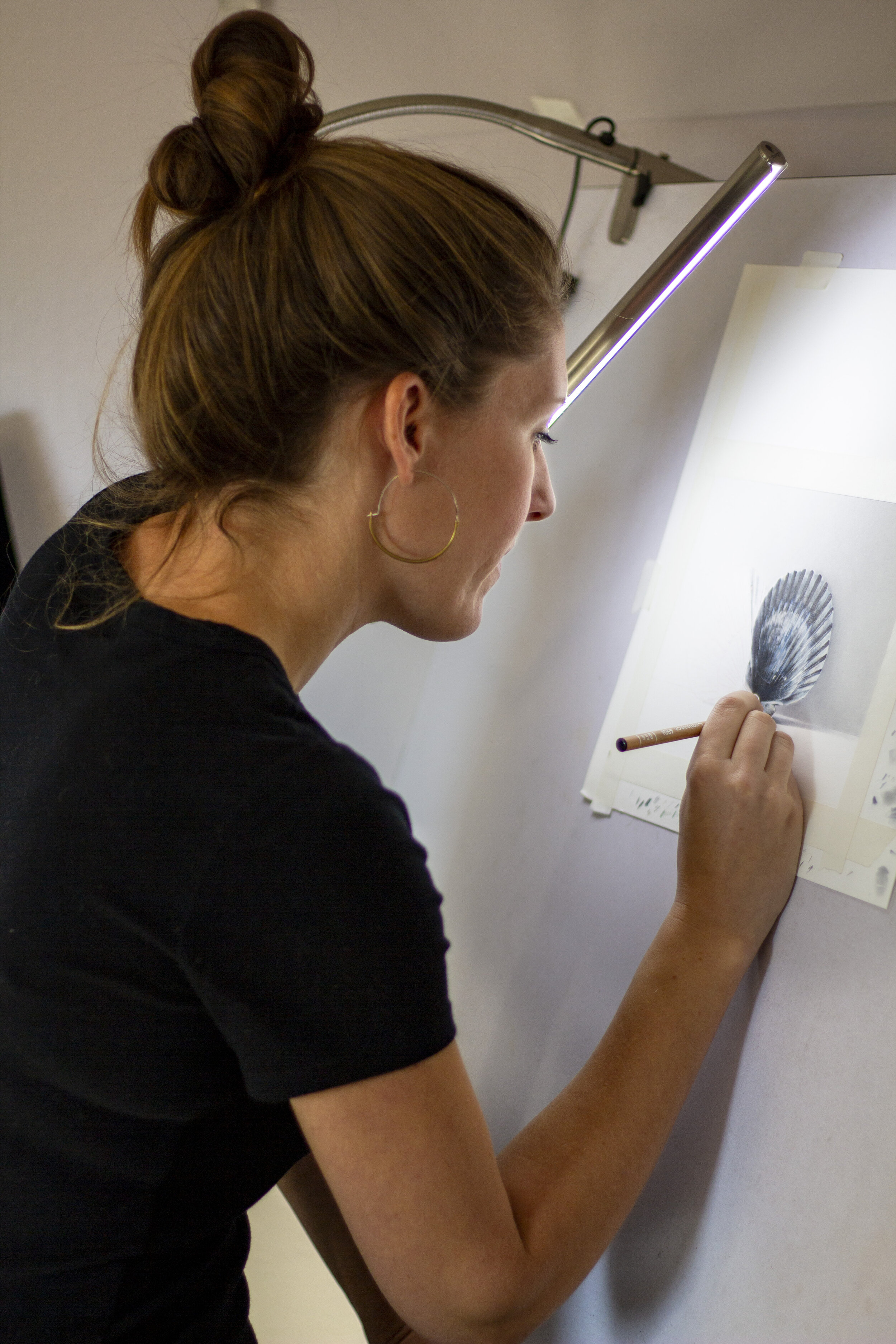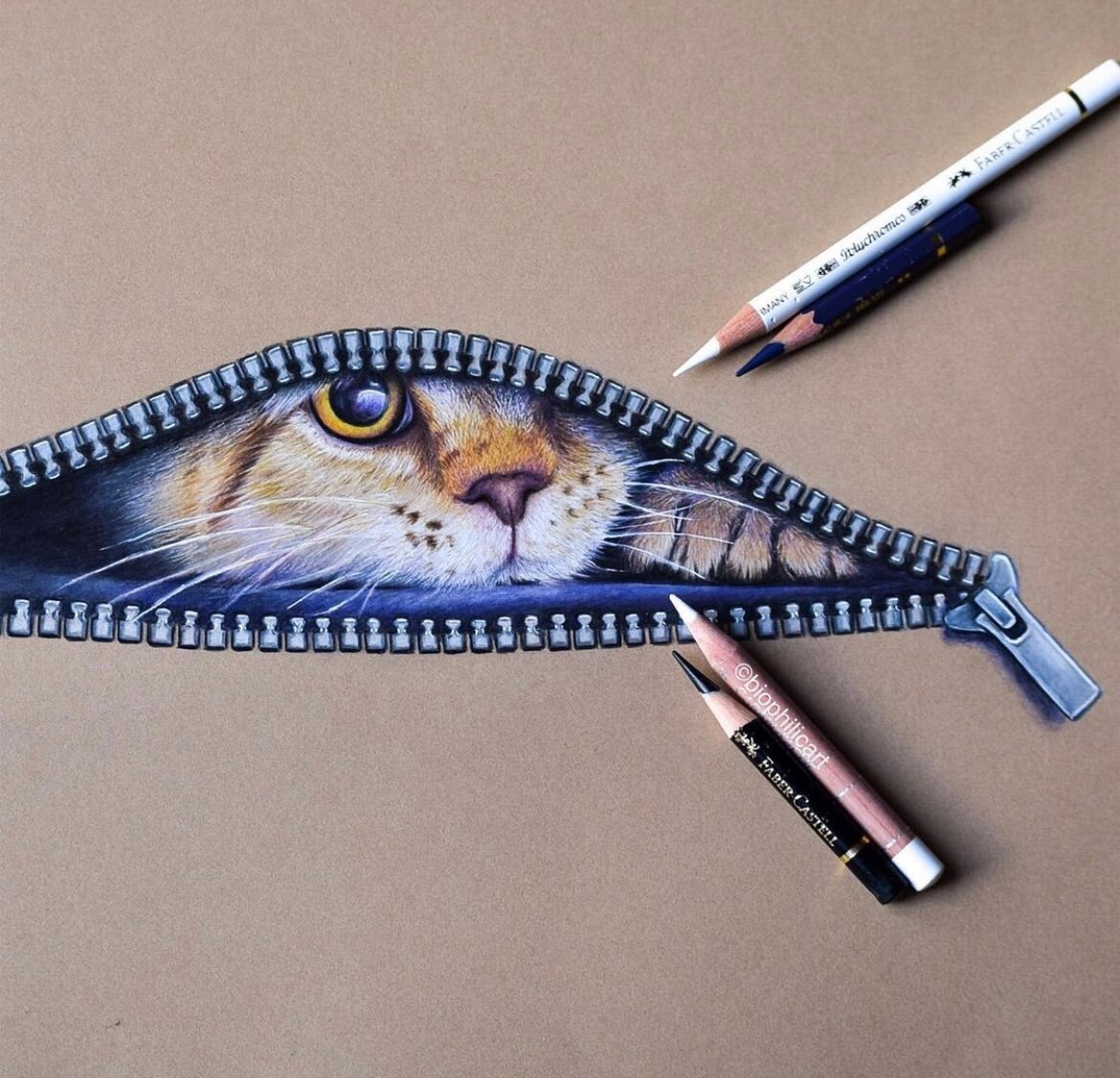What makes a paper great for colored pencil art? We asked some talented artists why they exclusively use the paper they work on. Whether it’s texture, size or color, each artist requires specific characteristics in a paper to fit their work.
As we suggest with most types of paper, there's no substitute for experimenting yourself. Visit our sample department for our Drawing Paper sampler.
We asked four colored pencil artists about the paper they use and why it works well for their work. Learn from Megan Seiter using Rising Museum Board, Sallann using Stonehenge Paper, Bella McGoldrick using Lenox Cotton and Wendy Hollender using Stonehenge Aqua Hotpress & Stonehenge Kraft.
Megan Seiter using Rising Museum Board
Tell us about yourself and your work.
I’m a colored pencil artist specializing in still life realism. I’ve been working with colored pencils for 13 years, and appreciate their ability to create luminous and highly detailed works of art. I’ve recently started experimenting with pan pastels and watercolors, which both work well alongside colored pencils. My most recent body of work is focused on botanicals. Floral subjects offer a breadth of variety in texture, color, and size, which can make for a beautiful and lively composition. I find my subjects at local farmers markets and flower shops, and take photos of the flowers while at their peak to use as a reference for each drawing.
What are your go-to materials?
The surface of a colored pencil drawing is incredibly important, and can drastically change the look and feel of a finished work of art. Rising Museum Board is my preferred surface, as it allows me to build each drawing with dozens of light layers of pencil without becoming oversaturated with wax. I use several brands of colored pencils, my favorite being the Luminance line by Caran d'Ache. They are a high-quality, deeply pigmented, soft and lightfast pencil, and they layer very nicely. I work with a Daylight Techne Artist and Drafting Lamp to light my drawing. Lighting isn’t often talked about, but it’s an integral tool that allows me to see fine details clearly under a neutral light. Rubber erasers are useful for lifting layers of pencils, and the Kum hand-held sharpener makes a very sharp pencil point (and the blades are easily replaceable).
What is the most important characteristic of a paper for you?
Layering is at the core of my technique. I build each drawing with dozens of light layers of pencil, which gives depth and luminosity to the work. It takes a specific type of paper to be able to hold on to so many layers of pencil. Some papers will start to flake with too many layers of pencil, and others will become oversaturated with wax after only a few layers (making it impossible to continue applying pencil to the drawing). That being said, the most important quality of a paper is its texture.
Colored Pencil on Rising Museum Board by Megan Seiter
What is it about Rising that works well for your artwork/style?
I look for a paper surface that’s toothy without being heavily textured. The texture of the Rising surface is ideal for colored pencil work. It comes in several plies, and I appreciate the sturdiness of the board (it won’t buckle with watercolor). I often incorporate oil-based pencils and pastels into my drawings, and both blend beautifully on this surface. The board also works well with the Slice Tool, which is a ceramic blade that I use to lift the top layers of pencil and to carve out the veins of a leaf.
Any advice for artists using Rising?
You can try almost any technique on this board with great success. It can handle a heavy hand, a blade, an electric eraser, a dozen layers of pencils, watercolors, pastels, and I’m sure almost anything else that you throw its way. I find that a light touch and a very sharp pencil is a great way to fill in the grain of the paper with ease. If you’re switching to Rising Museum Board for the first time, I would suggest using a scrap of the board to make a color chart. Your pencil colors will look different from one brand of paper to the next, and a chart will allow you to refer to your colors with accuracy and ease.
How do you use a shade of Rising for each piece?
It all depends on the mood of the drawing. Something light and airy will work best on white, while a dramatic and moody drawing looks great on black. Grey is an excellent option for drawings that have a wide range of values because you can still get bright whites and dark blacks, and it can be quicker to fill in the grain of the paper when you’re not working on a stark white surface.
Learn more about Megan’s work here.
Learn more about Rising Museum Board.
Sallyann using Stonehenge Paper
Colored Pencil on Stonehenge Kraft by @biophilicart
Tell us about yourself!
My name is Sallyann and l draw the things from nature that l love.
What are your go-to materials?
Always and only Stonehenge paper, l love it. I have tried many papers this is my favourite. Pencils - l use many brands, Faber Castell Polychromos and Caran D’ache Luminance and Pablo’s and Derwent Lightfast are my most used.
What is the most important characteristic of a paper for you?
The paper must allow me to layer colored pencil forever.
What is it about Stonehenge that works well for your artwork / style?
Stonehenge allows lots of layers, it is neither too gritty nor too smooth, it is very high quality and it is strong enough not to get random creases in it (as l am a little heavy handed).
Any advice for artists using Stonehenge?
Just to keep adding layers of color because Stonehenge will keep taking it and the more layers you add the more beautiful the finished piece becomes.
Stonehenge White
Stonehenge Steel Grey
Stonehenge Kraft
Since you use different shades of Stonehenge, how do you choose which shade for each piece?
I always look at the colours in the reference photo and use that as a guide for the color l will work with. It is amazing how colours that look quite similarly neutral can really look completely different when you add the colours you want to work with.
Learn more about Sallyann’s work.
Learn more about Stonehenge Paper.
Bella McGoldrick using Lenox Paper
Colored Pencil on Lenox by Bella McGoldrick
Tell us about yourself!
I’ve been drawing as my full time gig for 3 years now. I grew up in New Zealand and Australia and moved to nyc in 2016 which blew me away and inspired all my early works. I create hyper realistic drawings on paper with coloured pencils. Mainly still life but in a modern way I guess, usually just things around me wherever I’m living or things I source out when I’m travelling. These objects all mean something to me, or in their composition with other things tell some sort of a story, these days it’s more about wherever I’m living which changes monthly now. But I like the work to bring a connection to the viewer, either by nostalgia or memories of a place or time.
What are your go-to materials?
Tools are pretty simple and I’m always traveling and working so I have to keep it concise (which is hard with pencils) I use caran D’Ache and prisma color pencils, an eraser, an electric sharpener (essential) a traveling light, and good paper, always Lenox 100 250gsm. It really has to be those brands of pencils and that paper, I cannot veer from those two things. And then fixative when I’m finished, oh and shitty paper to cover my work whilst I’m working on small sections.
What is the most important characteristic of a paper for you?
Hmmm it’s kinda a combination and it’s more of the feel under the pencil. I always layer another sheet under the one I’m working on so as to not get any details from the table or work top coming through the paper. It has to be ever so slightly off white so as the white highlights in the drawings pop. But no yellow-ness. I like it visibly smooth but some tooth that I can feel. Surprisingly I’m not a perfectionist and I’m quite rough also with all the travel the paper has to have a good weight to it so withstand me and the moving around. So as heavy as I can get it, but this sometimes means there’s less tooth so it’s a perfect balance. Honestly it’s just really important to have consistency, things that I’m used to so as I can expect exactly how they’re going to react to my treatment. I spend too long on each piece (100-200hrs) to take any risks. And that also highlights how I need paper that it’s sturdy and strong!
What is it about Lenox that works well for you art/style?
The reason I first tried this paper was that I was able to get it at such a large size. I was limited by sheets before so that’s the first thing that suits me I get the 60”x20yrd rolls. Then the colour is great, white to the eye but I can still later white pigment on it and it pops off, the smoothness (whiteout being slippery) and sturdiness are perfect and what I’m used to so I won’t change it up now.
Any advice for artists using Lenox paper?
First important thing is be careful on what tape you use if you need to use tape, I usually tape other paper around the white edges of the work to keep them clean and I found out the hard way that some will tear the top layer of the paper off if they’re not good quality tapes. Then also if using coloured pencils be careful not to go to hard, as with any paper buy maybe slightly more with the Lenox because it’s not crazy toothy, there comes a point when the paper will take no more wax, it’s filled up basically, so you have to layer slowly, lightly and patiently. Oh and the third piece of advise is key!! The paper is dense enough that if you want a white highlight in the middle of colour, you can press really hard with the white pencil, in dent into the paper and when you softly shade over that area with another colour the white will shine through (the colour doesn’t go into the dent) this has saved me hours. So I do all my highlights first as the paper can take it.
Learn more about Bella McGoldrick and her work.
Learn more about Lenox.
Wendy Hollender using Stonehenge Aqua Hotpress
Intro- tell us about yourself and your work!
I am a botanical artist, illustrator, instructor, and author. I have worked across the world for over 20 years. My specialty is using colored pencils and watercolor pencils to create detailed botanical drawings and paintings. I live on a small farm in the foothills of the Catskills having started a garden here 12 years ago to provide food and inspiration for my work.
What are your go-to materials?
I work on hot pressed watercolor paper mostly . Stonehenge aqua hot pressed and Stonehenge paper in kraft and white or natural. I work with colored pencils and watercolor pencils.
What is the most important characteristic of a paper for you?
Paper needs to take layers of watercolor and pencil.
What is it about the paper that works well for your artwork?
The smoothness of these papers allows me to build layers quickly creating a detailed realistic drawing. Since I switched to using these papers, I can complete my artwork in a shorter amount of time.













